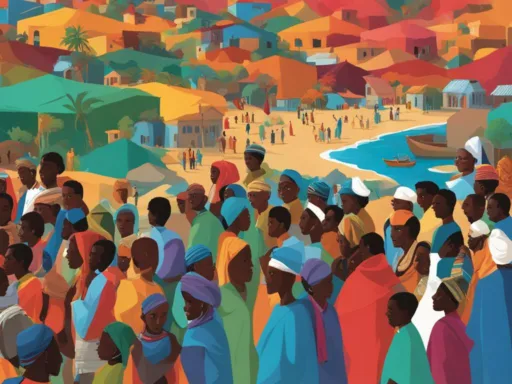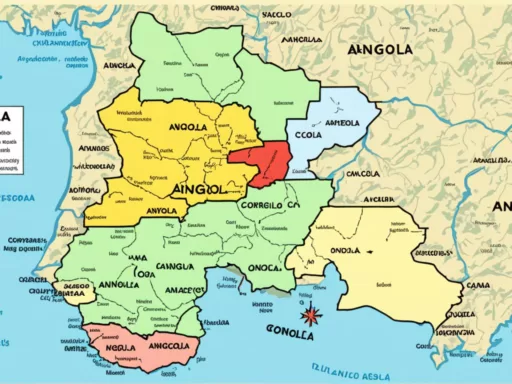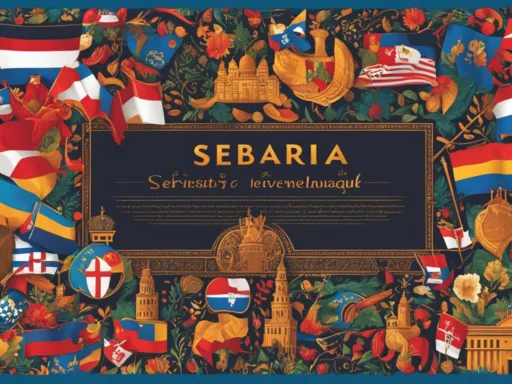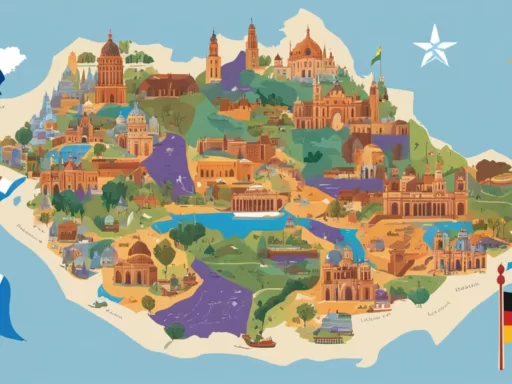Imagine a small island nation where nearly every citizen can effortlessly switch between three or four languages in a single conversation. In Mauritius, this multilingual ability isn’t just impressive; it’s the norm. The 2022 census reveals that over 90% of Mauritians understand and speak Mauritian Creole, contrasting the common perception of small island nations having limited linguistic diversity. Besides, this vibrant cultural mosaic has no official language inscribed in the Constitution. Instead, English and French are used in government proceedings, marking a unique case in the constellation of global linguistics.
Beyond the widespread use of the unofficial lingua franca, Mauritian Creole, and the preferred governmental languages, English and French, the languages spoken in Mauritius extend further into a medley of dialects and tongues. Bhojpuri, Chinese, Tamil, Telugu, Hindi-Urdu, and Arabic are also integral threads in the rich Mauritian languages tapestry, reflecting the island’s multiethnic heritage.
Key Takeaways
- Mauritian Creole is widely spoken and understood by nearly all Mauritians, though it is not the official language.
- The absence of an official language in Mauritius charts a special course in the linguistic diversity of the nation.
- English and French are prominent in governmental, judicial, and educational spheres, despite the broad use of Creole in daily life.
- Mauritius stands as a model of multilingualism, with the majority of its population being bilingual or trilingual.
- The multiplicity of languages spoken in Mauritius underlines the country’s complex historical and cultural narratives.
- Other languages such as Bhojpuri and various Indian and Chinese dialects play significant roles in the cultural identity of Mauritians.
Unveiling the Multilingual Landscape of Mauritius
The languages of Mauritius paint a vibrant picture of cultural synthesis, reflective of the island’s rich historical mosaic. Within this tapestry, the Creole language of Mauritius emerges as the predominant mode of expression, resonating in the homes of the vast majority of Mauritians. Yet, the linguistic portrait of this diverse nation wouldn’t be complete without acknowledging the significant roles played by other languages, notably the Bhojpuri language of Mauritius, which adds to the island’s distinctive cultural character.
The following table provides a snapshot of the linguistic preferences within Mauritian homes:
| Language | Percentage of Home Usage |
|---|---|
| Mauritian Creole | 90% |
| Bhojpuri | 5.1% |
| French | 4.4% |
| English | 0.6% |
As we delve deeper into understanding the linguistic plurality of Mauritius, it’s evident how each language contributes to the social fabric and self-identity of its citizens. The ubiquitous nature of Mauritian Creole unifies the population, while the persistence of Bhojpuri and other languages underscore the importance of heritage and ancestral ties in contemporary Mauritian society. The true essence of the island’s multilingual landscape manifests in everyday communication—a harmonious blend of languages, each with its unique relevance and beauty.
The Role of English and French in Mauritian Society
The linguistic fabric of Mauritius is rich and diverse, with English and French being pivotal in the societal functions of the island. Although Mauritius does not designate an official language in its Constitution, the English language in Mauritius serves as the cornerstone of governmental and bureaucratic communication. It dominates the legal and business arenas, assuring its status as a primary vehicle for official proceedings.
Contrastingly, the French language in Mauritius enjoys widespread use within the realms of media and educational settings. It reflects historical ties and a cultural affinity that has remained steadfast through the years. The prominence of French extends to local signage, presenting a bilingual vista that mirrors the recognized official languages of Mauritius in many international settings, similar to the formal bilingualism observed in Canada and Cameroon.
Bilingualism in English and French offers numerous advantages to Mauritians, bridging global communication gaps and fostering a multilayered society that reflects its colonial past while paving the way for a cosmopolitan future.
| Language | Domain of Use | Significance in Mauritian Society |
|---|---|---|
| English | Government, Legal, Business | Facilitates official and international communication; integral to legal and economic affairs. |
| French | Media, Education | Widely used in broadcast media and schools; retains cultural importance and historical connection. |
| Both English and French | Local Signage | Reflects the country’s bilingual character and enhances information accessibility for locals and tourists. |
In conclusion, as the English language Mauritius and French language Mauritius continue to coexist and flourish, they collectively contribute to the Island’s unique identity. The harmonious balance between these languages underscores their integral role in both honoring the rich tapestry of traditions in Mauritius and navigating the demands of a modern world.
The Heart of Mauritian Identity: Creole Language
The mosaic of languages spoken Mauritius reveals the essence of the island’s social fabric, with the Creole language Mauritius standing out as a cornerstone of the national identity. This vibrant dialect mirrors the country’s history, embodying the powerful blend of influences that have shaped the society over time.
Origins and Evolution of Mauritian Creole
Mauritian Creole’s roots stretch back to the era of colonialism, where it began as a simple method of communication and has since blossomed into a full-fledged dialect. Its historical beginnings as a pidgin used by African slaves have given way to a language rich in cultural significance, laden with words and idioms borrowed from French, English, Dutch, and Portuguese—each lending a voice in its lyrical narrative.
The Unofficial Lingua Franca of the Islands
Despite its lack of formal recognition, Mauritian Creole has emerged as the unofficial lingua franca, bridging the islands’ varied ethnic groups. It is the thread that weaves through the fabric of everyday life, present in the bustling markets, the rhythms of local music, and the spirited conversations of the people. In every corner of Mauritius, from the city streets to the rural heartlands, Creole facilitates camaraderie and connection in a way that few other languages can.
It is this undulating symphony of the Creole language Mauritius that echoes the diverse yet unified spirit of the nation—an intertwining of heritages that embodies what it truly means to be Mauritian.
Insight Into the Lesser Known Languages of Mauritius
While the languages of English and French may take precedence in the official discourse in Mauritius, the island’s cultural identity is equally shaped by the presence of Indian languages. These tongues carry with them the echoes of the past and offer a testament to the perseverance of cultural traditions amidst a rapidly globalizing world. The bounty of linguistic wealth in Mauritius includes the Bhojpuri language, Tamil, and Telugu—each contributing to the intricate mosaic of Mauritian languages. Embracing these Indian languages bolsters the ethnic diversity that Mauritius is known for, strengthening the fabric of its societal heritage.
Bhojpuri Language’s Deep-Rooted Influence
One cannot speak of the Mauritian languages without acknowledging the significant contributions of the Bhojpuri language. Bhojpuri in Mauritius is more than a mere means of communication; it encapsulates an entire legacy of the Indo-Mauritian community. Its survival and continual use in modern-day Mauritius are a testament to the resilience and vitality of a language that has for years been integral to the country’s plantation history. The language’s unique flavor and historical context attract interest from linguists and cultural enthusiasts alike, as it remains a cornerstone of the Indian languages in Mauritius.
Preservation of the Tamil, Telugu, and Other Indian Languages
The Mauritian dedication to preserving its linguistic heritage is further exemplified in the sustenance of Tamil and Telugu languages. These Indian languages, steeped in centuries of tradition, serve as cultural conduits, linking the Mauritian population to their ancestral legacies. The efforts towards the maintenance and appreciation of these languages have managed to keep their essence alive within the cultural tapestry of Mauritius, transcending generational boundaries and fostering a deep respect for linguistic diversity. Tamil language cultural activities and Telugu language celebrations remain a prominent part of community festivities.
In the table below, we showcase the influence and usage statistics that underscore the importance of these enduring languages in Mauritian society:
| Language | Home Language Usage | Community Association | Cultural Significance |
|---|---|---|---|
| Bhojpuri | 5.1% | Indo-Mauritian | Historical plantation narrative, folk traditions |
| Tamil | Data not specified | Indo-Mauritian, particularly Tamil community | Religious ceremonies, dance, and music |
| Telugu | Data not specified | Indo-Mauritian, particularly Telugu-speaking community | Cultural festivals, arts, and literature |
The celebration of the Indian languages Mauritius plays a crucial part in maintaining the heterogeneous yet unified national identity. Mauritian languages such as Bhojpuri, Tamil, and Telugu continue to thrive, nurturing a sense of pride and belonging among their speakers. The country’s linguistic landscape is an embodiment of its complex history and its contemporary commitment to cultural plurality.

The Arabic and Chinese Linguistic Presence
As a testament to the intricate tapestry of cultures that Mauritian society encompasses, the languages of Arabic and Chinese hold a special place. The echoes of these languages are not merely remnants of a bygone era but are living, breathing aspects of Mauritius’s social fabric. Within the mosaic of linguistic variety in Mauritius, the Arabic language has a revered status, particularly in religious and educational contexts. Connected to the historical and contemporary waves of migration, Arabic has been instilled in certain social pockets, maintaining its vitality through cultural practices and learning institutions.
Similarly, the Chinese community in Mauritius, with a history that threads back to the immigration of laborers and traders, contributes to the linguistic diversity with its multiple dialects. The Chinese language in Mauritius reverberates most profoundly within familial and community gatherings, entwining traditions with modern expressions of identity. Essential not solely for communication, these languages are symbolic threads in the fabric of a multicultural nation, embodying the spanning roots and interconnectedness of its communities.
- Maintaining Arabic Cultural Significance
- Vitality of the Chinese Language among Descendants
- Intergenerational Transfer of Linguistic Knowledge
Both Arabic and Chinese enjoy dissemination through cultural organizations and events that honor the rich heritage of Mauritius’s people. Heritage languages such as these, while having specific concentrations within their respective communities, contribute to the linguistic variety in Mauritius by offering unique perspectives and knowledge to the island’s collective wisdom.
Understanding the Importance of Multilingualism in Mauritius
The island nation of Mauritius, renowned for its stunning landscapes and cultural diversity, also showcases a fascinating feature in its everyday communication—the layers of multilingualism benefits. Indeed, multilingualism in Mauritius is not merely a characteristic of the population but a fundamental aspect that contributes to the fabric of this vibrant society.

Socioeconomic Benefits of Language Diversity
In a business landscape that increasingly values global reach and intercultural negotiation, the linguistic prowess of Mauritius stands out. It is widely recognized that multilingual proficiency sharpens cognitive abilities and enhances problem-solving skills—a valuable asset in the competitive global marketplace. This very advantage paves the way for improved trade relations and economic ventures, as Mauritian professionals can seamlessly liaise with partners from varied linguistic backgrounds. The interwoven languages, reflecting the island’s history of settlement and trade, serve as a beacon of socioeconomic progress, enticing investors and entrepreneurs alike to do business in a milieu where communication barriers are notably absent.
Navigating Through Languages: The Mauritian Way of Life
Life in Mauritius is a captivating dance between languages, with everyday communication seamlessly transitioning from Creole to French or English, and various Asian languages adding their own unique cadence. This multilingualism Mauritius enjoys, prompts a society that thrives on the collaborative spirit engendered by bilingualism and trilingualism. Social cohesion is strengthened as individuals cross cultural divides, forming bonds that are both deep and resilient. From the bustling markets to the corridors of education, language is the avenue through which Mauritians connect and collaborate, weaving a society that rejoices in its unity while honoring its cultural diversity. As they navigate through their day, Mauritians exemplify how a multilingual sociocultural landscape can foster an inclusive community bound by mutual respect and shared experiences.
Official vs. National Languages: A Constitutional Perspective
The intricate fabric of language in Mauritius, woven with a rich blend of cultural threads, presents an interesting case when viewed through the constitutional lens. While the official languages Mauritius holds dear are not enshrined within the Constitution, the document does suggest the utilization of English and French within the esteemed walls of the National Assembly. This presents a fascinating legal dichotomy with the everyday vernacular of the people—Mauritian Creole—remaining the national language in practice but lacking formal legislative recognition.
This discrepancy touches on a broader dialectic, one that resonates across the societal domain, charting a course between ceremonious officialdom and the pragmatic dynamics of societal linguistics.
The absence of a designated constitutional language Mauritius recognizes, coupled with the allegiance to English and French in legislative proceedings, underscores the niche that Mauritian Creole has naturally carved for itself—existing not only as a language but as a vital component of national identity.
It’s in the day-to-day exchanges, the bustling marketplaces, and the communal spaces where the linguistic heart of Mauritius beats strongest, unabated by the lack of a constitutional proclamation. In these spaces, a vibrant symphony of voices articulates the reality that while the island may be governed without a declared official language, it thrives on the rich, unofficial tongue of its people.
Prominent Role of Language in Mauritian Education
The educational system in Mauritius exemplifies a remarkable linguistic duality, largely characterized by education language Mauritius, where the influence of both English and French is prevalent. These languages serve not only as mediums of instruction but also as key determinants of academic success and accessibility to global opportunities.
Medium of Instruction: Balancing English and French
In the pursuit of educational excellence, Mauritius meticulously balances French medium instruction with English medium instruction. This bicultural approach equips students with the proficiencies necessary to excel both locally and internationally. As English is the predominant language used in the curriculum, students receive their education within a framework designed to enhance global competitiveness.

How Language Shapes Educational Outcomes in Mauritius
The correlation between language and educational outcomes Mauritius is profound. Mastery over English and French opens a gateway to a myriad of academic and professional possibilities, ensuring students are well-prepared for the demands of the global workforce. Moreover, the language impact Mauritius has on education cannot be understated; inherently, it fosters a population capable of adaptive thinking and cross-cultural communication, prime assets in our increasingly interconnected world.
Symbols of Unity: Signages in Multiple Languages
Wandering through the bustling streets and serene pathways of Mauritius reveals the essence of its cultural unity through a rich tapestry of multilingual signages. These signs, more than mere functional guides, stand as testament to the nation’s respect for its colorful linguistic heritage. Displayed prominently in public spaces, multilingual signages in Mauritius symbolize the island’s commitment to a society where diversity is embraced and celebrated.
As tourists stroll along the beaches and marketplaces, they encounter signages in a variety of languages – from the vibrant Kreol and classic French to the melodic Bhojpuri, reflecting not only linguistic variety but the beating heart of cultural unity in Mauritius. It’s an immersive experience that connects individuals from all walks of life, fostering an environment of mutual respect and collaboration.
| Location | Languages Displayed | Cultural Significance |
|---|---|---|
| Port Louis Market | Creole, English, French | A central hub that represents the melting pot of the nation’s diverse ethnic groups. |
| Grand Baie | Creole, English, French, Hindi | Popular tourist area that showcases the blend of international and local cultures. |
| Flic en Flac | Creole, English, French, Chinese | Beachfront locale exhibiting ties with the Chinese community and tourists. |
| Mahebourg Waterfront | Creole, English, French, Tamil, Telugu | A historical site where the Indian diaspora’s presence is vibrantly displayed. |
| Caudan Waterfront | Creole, English, French, Bhojpuri | A showcase of Mauritius’s economic development alongside cultural inclusivity. |
The strategic placement and design of these signages not only aid in navigation but also serve as silent educators, teaching visitors about the island’s respect for its history and its people’s ability to live in harmonious diversity. Thus, they solidify the notion that language in Mauritius is not simply a means of communication, but a bridge uniting its people under the collective identity of this island paradise.
The Intricacies of the Mauritian Sign Language
In Mauritius, the vibrant patchwork of spoken languages is enriched further by the visual language of the deaf community—Mauritian Sign Language. This form of non-verbal communication stands as a testament to the island’s dedication to cultural inclusivity and diversity.
Recognizing the Deaf Community: A Cultural Integration
Acknowledging and embracing the deaf community in Mauritius goes beyond social integration; it’s about cherishing the cultural dimensions that the Mauritian Sign Language brings to the nation. The government and various organizations continue to strive toward full inclusion for the hearing impaired, ensuring that every individual has the opportunity to fully participate in societal life.
Sign Language: Bridging Communication Gaps
Central to the efforts of improving inclusivity in Mauritius is the role of sign language communication. It stands as a powerful bridge, mitigating the barriers faced by those with hearing impairments, enabling them to access information, services, and forge social connections that are imperative for a unified national community.
Through educational programs, public awareness campaigns, and the integration of sign language into media and public services, Mauritius is leading by example in sign language communication. This commitment ensures that all members of society can contribute to and benefit from the rich cultural life of the island, in line with a broader vision for inclusivity in Mauritius.
Conclusion
As we look to the horizon, the linguistic culture of Mauritius stands at a crossroads where tradition meets innovation. Globalization and technological innovation present powerful catalysts for language evolution in Mauritius, signaling the potential emergence of new dialects and means of expression. This dynamic interplay between progress and heritage ensures that the languages spoken in Mauritius will continue to paint a vivid portrait of the island’s past while adapting to the rhythms of its inevitable future growth.
The Future of Linguistic Culture in Mauritius
The promise of maintaining an inclusive linguistic diversity Mauritius has cherished for so long is not without its challenges. Yet, it’s clear that the vibrant cultural symphony of the island will continue to echo through everyday interactions, preserving a unique identity in an ever-changing global landscape. Language evolution in Mauritius is not merely an academic interest but a living process that touches the heart of the nation’s societal fabric, embracing both the individuality and collectivity of its people.
Embracing the Linguistic Tapestry: What Lies Ahead
Ahead lies a world rich with opportunities for Mauritius to reinforce its commitment to its multilingual heritage. This promise for the future bolsters the presence of every dialect—from the open markets where Creole buzzes, through the classrooms where English and French contribute to the top-tier education, to the quiet whisper of ancestral languages that solidify the irreplaceable roots of many Mauritian families. Embracing the linguistic tapestry before us, Mauritius continues to sow the seeds of understanding, collaboration, and cultural synergy, fortifying an enduring legacy for generations to come.
FAQ
What Languages are Spoken in Mauritius?
Mauritius is a linguistically diverse island where a variety of languages are spoken. The most widely spoken language is Mauritian Creole, which is understood by the majority of the population. English and French are used in government, education, and media, and are common in public signage. Other spoken languages include Bhojpuri, Chinese, Tamil, Telugu, Hindi-Urdu, and Arabic. Most Mauritians are bilingual or trilingual, navigating fluently between languages in their daily lives.
Are there Official Languages in Mauritius?
The Constitution of Mauritius does not specify any official languages. However, English is used as the primary language of government and administration, and French is also widely used in media and education. Both English and French are used in the National Assembly, reflecting their significance in formal and official settings.
How Prevalent is the Creole Language in Mauritius?
The Creole language is the heart of Mauritius’ linguistic identity and is spoken by approximately 90% of the population. It acts as the lingua franca across the island and is used primarily in informal settings, while also reflecting a synthesis of various cultural influences including French, English, Dutch, and Portuguese.
What is the Role of Bhojpuri and Other Indian Languages in Mauritius?
Bhojpuri holds a special place within the Indo-Mauritian community, constituting a significant part of the island’s linguistic heritage. Alongside Bhojpuri, other Indian languages such as Tamil and Telugu are preserved and celebrated as part of the island’s cultural identity, contributing to the overall diversity of languages in Mauritius.
How Do Arabic and Chinese Contribute to the Linguistic Landscape of Mauritius?
Arabic and Chinese languages contribute to the linguistic diversity of Mauritius and are spoken within their respective communities, mirroring the island’s multicultural and multiethnic society. They represent the historical and cultural bonds Mauritius shares with various regions of the world.
What are the Socioeconomic Benefits of Multilingualism in Mauritius?
Multilingualism in Mauritius enhances intercultural communication and fosters social cohesion. It also provides competitive advantages in global trade and business, equipping Mauritians with the linguistic skills to navigate various cultural and economic landscapes.
What is the Medium of Instruction in Mauritian Schools?
In Mauritian public schools, English is the primary medium of instruction, while French is prominently used in literature, media, and as a part of the school curriculum. The education system reflects the island’s bilingual context, which plays a critical role in shaping educational outcomes.
How is Sign Language Integrated into Mauritian Society?
Mauritian Sign Language is an important mode of communication for the deaf community, and efforts are being made to promote its recognition and facilitate its use in public life. The integration of sign language is vital to fostering inclusivity and ensuring equal access for all members of society.
What Does the Future Hold for the Linguistic Culture in Mauritius?
The dynamic linguistic culture of Mauritius is expected to continue evolving with globalization and technological advancements. The island nation looks forward to a future where language remains central to social unity and cultural exchange, adapting to new influences while valuing its diverse linguistic tapestry.






